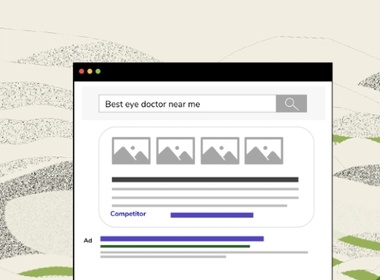SEO Copywriting 101: A Basic SEO Guide for Content Marketers
Effectively write SEO optimized content using Conductor's SEO 101 Guide to Content Marketing, perfect for both people and search engines.
You’re a content marketer. You write great content. You promote your brand. You educate your customers. You answer your readers' questions. So why does creating SEO-friendly content matter?
The fact is, creating an SEO content marketingContent Marketing
Content marketing is a marketing discipline with the goal of increasing awareness and scope for products and brands in the desired target group with content published on the web and offline.
Learn more strategy can take that informative piece of content you just finished and get it noticed by the most important members of your audience and at a larger scale.
Where should I start with SEO?
Knowing where to start with SEO copywriting is often the hardest part. That’s why we’ve created this step-by-step beginners guide to SEO for content marketers. It will help you learn SEO basics and show you the most important components of effective SEO copywriting in easy-to-understand terms. You’ll become an SEO content writing expert in no time.
What are the 3 main components of SEO content?
Think of SEO as another checkbox on the content distribution checklist. Search engines like Google rank pages on:
- High-quality content
- Relevance
- Context
The modern world of SEO and content marketing has evolved from the dark ages of forcing random keywords into your copywriting (called “keywordKeyword
A keyword is what users write into a search engine when they want to find something specific.
Learn more stuffing”) to the modern world of integrating keywords into strategic places within your content.
How is SEO used in content writing?
A crucial step in SEO content writing is placing the right keywords in the right places. Some best practices:
- Include keywords in H1, H2 or H3 tags. When Google crawls your page, it reads header tags as it would a table of contents to discover the main focus of the page content.
- Use keywords and LSI terms only where they make sense, but avoid overusing a keyword, which can negatively affect the page rank. (LSI = Latent Semantic Indexing. They’re the secondary keyword topics that give your SEO content more context.
- Update image alt tags to include keywords on every web page.
- Don’t forget about the meta descriptionMeta Description
The meta description is one of a web page’s meta tags. With this meta information, webmasters can briefly sketch out the content and quality of a web page.
Learn more. You’ll find it directly under the title and URL in a Google search resultSearch Result
Search results refer to the list created by search engines in response to a query.
Learn more. - Include keywords within the page URL. Insert them as close to the root of the URL as possible.
If you want to learn more, check out this handy list of 5 Tips for SEO Content Writing.
How to write SEO content
Ideally, the best SEO content begins in the ideation phase. Doing keyword research can help you in two ways:
- When you have a topic in mind, start by asking how you can increase search demand around that topic.
- When you need to find a topic, start by figuring out what questions your customers are asking.
For a deep dive into the three stages of SEO content creation—ideating, planning, and creation—read this guide on How to Create Great Web Content.
What do you need to know about Google’s search engine algorithm?
It changes daily. But no matter how many changes Google makes, its algorithm focuses on one single goal: providing the best user experienceUser Experience
User experience (or UX for short) is a term used to describe the experience a user has with a product.
Learn more. It's helpful content update from August 2022 is good example of that.
That’s why aligning your SEO content marketing strategy with customers when searching is the best way to optimize your content, regardless of algorithm changes.
SEO and content marketing: How to find the right keywords
Finding the right target keywords is a key part of knowing how to write SEO content. Consider:
- Search volume: How many people search using this keyword each month?
- Search intent: Are users looking to research or buy?
- Competition: Who else ranks for this keyword? What competitionCompetition
Businesses generally know who their competitors are on the open market. But are they the same companies you need to fight to get the best placement for your website? Not necessarily!
Learn more do they provide?
A keyword research tool such as Google’s Keyword Planner or Conductor’s Conductor's Explorer tool can help you discover monthly search volumeSearch Volume
Search volume refers to the number of search queries for a specific keyword in search engines such as Google.
Learn more (MSV).
How many keywords should you target in SEO copywriting?
Best practices suggest targeting five keywords per piece of content. Doing so will help you rank well for other topics and phrases associated with those keywords.
You can also choose to focus on just one primary keyword for an individual piece of content. And then use variations of that keyword to inform and support the various sub-topics that piece of content covers. For example, if 'keyword research' was your primary keyword, you might decide to address 'what is keyword research', 'why is keyword research important', 'examples of keyword research', and 'how do you do keyword research' based on the MSV of those keyword variations.
How do I find keywords for my personas?
Analyzing the words and phrases customers use to search for your products can indicate where they are in the buyer’s journey. For example, if you’re marketing a dishwasher:
- Early-stage search: “How to wash dishes”
- Mid-stage search: “Best dishwasher with a delayed start on control panel”
- Late-stage search: “Buy [brand name] dishwasher”
What should you look for when researching SERP?
- Answer boxes—the first result in a SERP that provides information without needing to click—are a key target for an effective SEO strategy. This content is front and center, making it easy to find. These are also known as Featured SnippetsFeatured Snippets
Featured snippets are highlighted excerpts of text that appear at the top of a Google search results page in what is known as ‘Position 0’.
Learn more. - People Also Ask boxes—located underneath the answer boxes—are great ways to get information about what other specific keyword queries your searchers are seeking. Use topics in these boxes to spark topic ideas or even build an outline for SEO friendly content.
What is on-page SEO?
Your on-page SEO helps you optimize your content for search engines to gain visibility. It also shows search engines that your content displays expertise, authoritativeness, and trustworthiness— called EAT SEO. This will improve your ranking results and help you gain organic traffic.
We’ve created this handy, downloadable, on-page SEO guide to help you learn more about how to write SEO content.
Do you need a content audit?
Content audits sound daunting. But they’re vital. If you see that a bulk of site traffic is leading to older pages, a content audit will allow you to:
- Fully understand the scope of your current content library
- Determine which existing content may have changed since it was published and needs to be refreshed
- Fix other pages that aren’t getting the traffic they deserve
How do you conduct a content audit?
First, identify older site pages that aren’t receiving organic traffic. Then, prioritize critical pages to audit using if/then statements. Filter pages that rank 3 or higher but have fewer than 100 visits. These have the greatest potential for a turnaround!
Which factors help my SEO ranking?
Top factors that help your ranking include:
- High-quality content: Pages and article that are fresh, practical, and relevant
- Mobile-friendliness: Sites that use a responsive or 100% mobile design
- High-quality backlink: Google views these as a “vote of confidence” from others and boosts SEO authority
- Domain authority: Authority is influenced by your total number of links and your domain’s age, popularity, and size
- On-page SEO: Important on-page SEO components include title tags, meta description, header tags, URLs, and image alt tags
Follow these tips to create SEO-friendly content
When search engines find your copy, your readers will, too. Using these SEO content and copywriting tips will help you attract new visitors, rank higher on search engines, and gain more valuable traffic.
Request a live demo of our platform and experience how we can take your SEO content marketing strategy even further.







